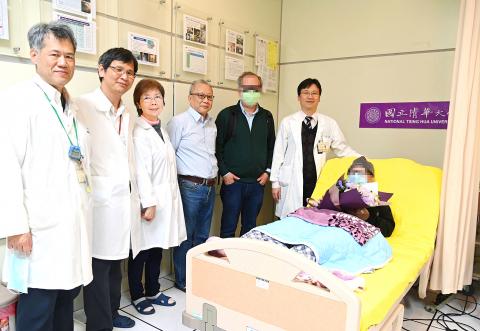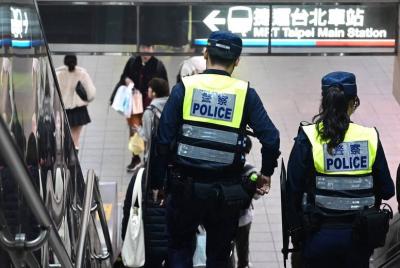More than 120 people with brain or head and neck cancer have been treated with a boron neutron capture therapy developed by National Tsing Hua University, a team of researchers said yesterday.
The nation’s only research nuclear reactor was owned by the university, which converted it into a device for clinical therapy and established the Boron Neutron Capture Therapy Center.
The conversion was not directly related to the nation’s change in nuclear power policy, center director Lee Min (李敏) said, adding that the university’s College of Nuclear Science had been exploring more applications for radiation.

Photo courtesy of National Tsing Hua University via CNA
In the 1990s, the college sent personnel to learn the therapeutic technique at the Massachusetts Institute of Technology, where the first clinical trials were conducted, he said, adding that only Taiwan and Japan have continued to develop and use it in clinical applications.
In the therapy, drugs containing boron — a nonmetal element used in nuclear reaction — are injected in cancer patients and accumulate in tumors, which are then irradiated by a neutron beam generated by the reactor, Institute of Nuclear Engineering and Science professor Chou Fong-in (周鳳英) said.
High-energy particles produced through nuclear reactions kill tumor cells without affecting normal cells, making the therapy suitable for combating tumors that are widespread and harder to surgically remove, she said.
After the cancer cells absorb the drugs, the high-energy radiation “ignites” the drugs, which function like “explosives,” annihilating the malignant cells, Taipei Veterans General Hospital oncologist Chen Yi-wei (陳一瑋) said.
Through a connection between the center and the International Society for Neutron Capture Therapy, a Spanish woman in October last year arrived in Taiwan for treatment of a malignant tumor in her brain stem, the team said, withholding the woman’s name to protect her privacy.
After receiving an examination at the hospital, the woman last month visited the center to receive the therapy, which reduced her tumor from 3.51cm to 1.06cm, it said.
As her second radiation session was scheduled for Feb. 14, the team helped the woman mark Valentine’s Day, with her husband — who is a physician — preparing a bouquet to celebrate her recovery, it added.
The woman has returned to Spain for follow-up observation, Lee said.
As it is a relatively new therapy, cancer patients can only receive it after careful evaluations by doctors and personnel from the center, and as well as with case-by-case approval from the Food and Drug Administration, he said.
Since the center started working with physicians at the hospital in 2010, more than 120 patients have received the therapy, he added.
The university is also working with the Taoyuan City Government on a planned affiliated hospital at the Taoyuan Aerotropolis, Lee said, adding that he hopes the therapy would benefit more patients.

Beijing could eventually see a full amphibious invasion of Taiwan as the only "prudent" way to bring about unification, the US Department of Defense said in a newly released annual report to Congress. The Pentagon's "Annual Report to Congress: Military and Security Developments Involving the People's Republic of China 2025," was in many ways similar to last year’s report but reorganized the analysis of the options China has to take over Taiwan. Generally, according to the report, Chinese leaders view the People's Liberation Army's (PLA) capabilities for a Taiwan campaign as improving, but they remain uncertain about its readiness to successfully seize

Taiwan is getting a day off on Christmas for the first time in 25 years. The change comes after opposition parties passed a law earlier this year to add or restore five public holidays, including Constitution Day, which falls on today, Dec. 25. The day marks the 1947 adoption of the constitution of the Republic of China, as the government in Taipei is formally known. Back then the Chinese Nationalist Party (KMT) governed China from Nanjing. When the KMT, now an opposition party in Taiwan, passed the legislation on holidays, it said that they would help “commemorate the history of national development.” That

Taiwan has overtaken South Korea this year in per capita income for the first time in 23 years, IMF data showed. Per capita income is a nation’s GDP divided by the total population, used to compare average wealth levels across countries. Taiwan also beat Japan this year on per capita income, after surpassing it for the first time last year, US magazine Newsweek reported yesterday. Across Asia, Taiwan ranked fourth for per capita income at US$37,827 this year due to sustained economic growth, the report said. In the top three spots were Singapore, Macau and Hong Kong, it said. South

Police today said they are stepping up patrols throughout the Taipei MRT system, after a social media user threatened to detonate a bomb at an unspecified station this afternoon. Although they strongly believe the threat to be unsubstantiated, Taipei Metro police and the Railway Police Bureau still said that security and patrols would be heightened through the system. Many copycat messages have been posted since Friday’s stabbing attacks at Taipei Main Station and near Zhongshan MRT Station that left three dead and 11 injured, police said. Last night, a Threads user in a post said they would detonate a bomb on the Taipei